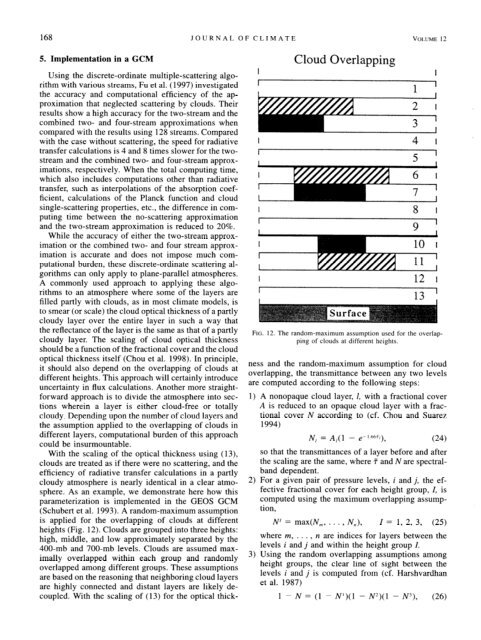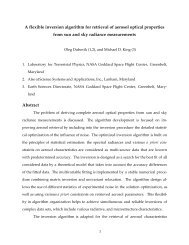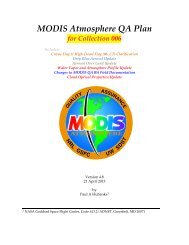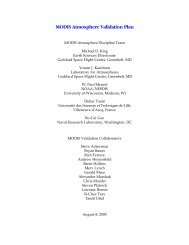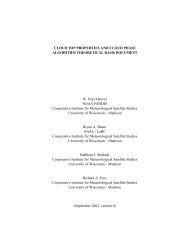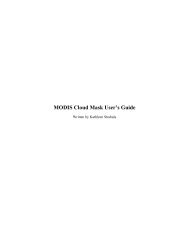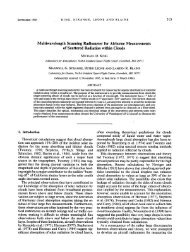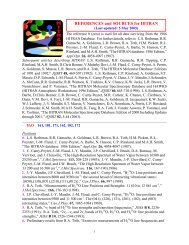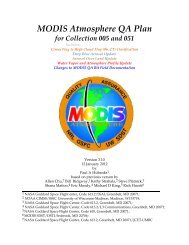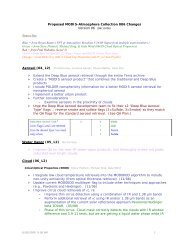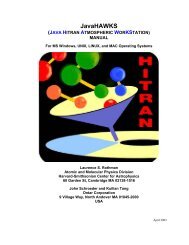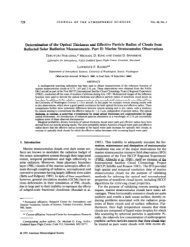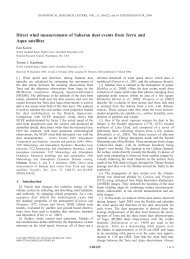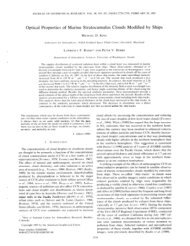Chou et al. (1999).pdf - MODIS Atmosphere - NASA
Chou et al. (1999).pdf - MODIS Atmosphere - NASA
Chou et al. (1999).pdf - MODIS Atmosphere - NASA
Create successful ePaper yourself
Turn your PDF publications into a flip-book with our unique Google optimized e-Paper software.
168 JOURNAL OF CLIMATE VOLUME 12<br />
5. Implementation in a GCM<br />
Using the discr<strong>et</strong>e-ordinate multiple-scattering <strong>al</strong>go-<br />
rithm with various streams, Fu <strong>et</strong> <strong>al</strong>. (1997) investigated<br />
the accuracy and computation<strong>al</strong> efficiency of the ap-<br />
proximation that neglected scattering by clouds. Their<br />
results show a high accuracy for the two-stream and the<br />
combined two- and four-stream approximations when<br />
compared with the results using 128 streams. Compared<br />
with the case without scattering, the speed for radiative<br />
transfer c<strong>al</strong>culations is 4 and 8 times slower for the two-<br />
stream and the combined two- and four-stream approx-<br />
imations, respectively. When the tot<strong>al</strong> computing time,<br />
which <strong>al</strong>so includes computations other than radiative<br />
transfer, such as interpolations of the absorption coef-<br />
ficient, c<strong>al</strong>culations of the Planck function and cloud<br />
single-scattering properties, <strong>et</strong>c., the difference in com-<br />
puting time b<strong>et</strong>ween the no-scattering approximation<br />
and the two-stream approximation is reduced to 20%.<br />
While the accuracy of either the two-stream approx-<br />
imation or the combined two- and four stream approx-<br />
imation is accurate and does not impose much com-<br />
putation<strong>al</strong> burden, these discr<strong>et</strong>e-ordinate scattering <strong>al</strong>-<br />
gorithms can only apply to plane-par<strong>al</strong>lel atmospheres.<br />
A commonly used approach to applying these <strong>al</strong>go-<br />
rithms to an atmosphere where some of the layers are<br />
filled partly with clouds, as in most climate models, is<br />
to smear (or sc<strong>al</strong>e) the cloud optic<strong>al</strong> thickness of a partly<br />
cloudy layer over the entire layer in such a way that<br />
the reflectance of the layer is the same as that of a partly<br />
cloudy layer. The sc<strong>al</strong>ing of cloud optic<strong>al</strong> thickness<br />
should be a function of the fraction<strong>al</strong> cover and the cloud<br />
optic<strong>al</strong> thickness itself (<strong>Chou</strong> <strong>et</strong> <strong>al</strong>. 1998). In principle,<br />
it should <strong>al</strong>so depend on the overlapping of clouds at<br />
different heights. This approach will certainly introduce<br />
uncertainty in flux c<strong>al</strong>culations. Another more straight-<br />
forward approach is to divide the atmosphere into sec-<br />
tions wherein a layer is either cloud-free or tot<strong>al</strong>ly<br />
cloudy. Depending upon the number of cloud layers and<br />
the assumption applied to the overlapping of clouds in<br />
different layers, computation<strong>al</strong> burden of this approach<br />
could be insurmountable.<br />
With the sc<strong>al</strong>ing of the optic<strong>al</strong> thickness using (13),<br />
clouds are treated as if there were no scattering, and the<br />
efficiency of radiative transfer c<strong>al</strong>culations in a partly<br />
cloudy atmosphere is nearly identic<strong>al</strong> in a clear atmo-<br />
sphere. As an example, we demonstrate here how this<br />
param<strong>et</strong>erization is implemented in the GEOS GCM<br />
(Schubert <strong>et</strong> <strong>al</strong>. 1993). A random-maximum assumption<br />
is applied for the overlapping of clouds at different<br />
heights (Fig. 12). Clouds are grouped into three heights:<br />
high, middle, and low approximately separated by the<br />
400-mb and 700-mb levels. Clouds are assumed max-<br />
im<strong>al</strong>ly overlapped within each group and randomly<br />
overlapped among different groups. These assumptions<br />
are based on the reasoning that neighboring cloud layers<br />
are highly connected and distant layers are likely de-<br />
coupled. With the sc<strong>al</strong>ing of (13) for the optic<strong>al</strong> thick-<br />
I<br />
Cloud Overlapping<br />
I 4 I<br />
I<br />
I<br />
12 I<br />
13 f<br />
FIG. 12. The random-maximum assumption used for the overlap-<br />
ping of clouds at different heights.<br />
ness and the random-maximum assumption for cloud<br />
overlapping, the transmittance b<strong>et</strong>ween any two levels<br />
are computed according to the following steps:<br />
1)<br />
2)<br />
3)<br />
A nonopaque cloud layer, 1, with a fraction<strong>al</strong> cover<br />
A is reduced to an opaque cloud layer with a frac-<br />
tion<strong>al</strong> cover N according to (cf. <strong>Chou</strong> and Suarez<br />
1994)<br />
N, = A,( 1 - e-’ 66i), (24)<br />
so that the transmittances of a layer before and after<br />
the sc<strong>al</strong>ing are the same, where f and N are spectr<strong>al</strong>-<br />
band dependent.<br />
For a given pair of pressure levels, i and j, the ef-<br />
fective fraction<strong>al</strong> cover for each height group, Z, is<br />
computed using the maximum overlapping assump-<br />
tion,<br />
N’ = max(N,, . . . , N,,), I = 1, 2, 3, (25)<br />
where m, . . . , n are indices for layers b<strong>et</strong>ween the<br />
levels i and j and within the height group I.<br />
Using the random overlapping assumptions among<br />
height groups, the clear line of sight b<strong>et</strong>ween the<br />
levels i and j is computed from (cf. Harshvardhan<br />
<strong>et</strong> <strong>al</strong>. 1987)<br />
1 - N = (1 - N’)(l - N*)(l - N’), (26)


